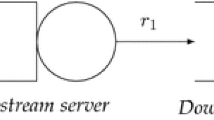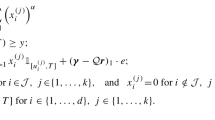Abstract
We consider a multi-station fluid model with arrivals generated by a large number of non-homogeneous heavy-tailed On/Off sources. If the model is feed-forward in the sense that fluid cannot flow from one station to other with lighter tail distributions, we prove that under heavy-traffic, the scaled workload converges in distribution to a reflected fractional Brownian motion process with a multi-dimensional Hurst parameter. As an application, we analyze the impact of having independent streams with variable parameters in high-speed telecommunication networks, on the asymptotic behavior of the maximum queue length.
Similar content being viewed by others
References
Bernard, A., el Kharroubi, A.: Régulations déterministes et stochastiques dans le premier orthant de ℝn. Stoch. Stoch. Rep. 34, 149–167 (1991)
Biagini, F., Hu, Y., Øksendal, B., Sulem, A.: A stochastic maximum principle for processes driven by fractional Brownian motion. Stoch. Process. Appl. 100, 233–253 (2002)
Debicki, K., Mandjes, M.: Traffic with an fBm limit: convergence of the stationary workload process. Queueing Syst. 46, 113–127 (2004)
Delgado, R.: A reflected fBm limit for fluid models with ON/OFF sources under heavy traffic. Stoch. Process. Appl. 117, 188–201 (2007)
Delgado, R.: On the reflected fractional Brownian motion process on the positive orthant: asymptotics for a maximum with application to queueing networks. Stoch. Models 26, 272–294 (2010)
Duncan, T.E., Jin, Y.: Maximum queue length of a fluid model with an aggregated fractional Brownian input. In: Markov Processes and Related Topics. IMS Collections, vol. 4, pp. 235–251 (2008)
Ethier, S.N., Kurtz, T.G.: Markov Processes: Characterization and Convergence. Wiley, New York (1986)
Fitzpatrick, J., Murphy, S., Murphy, J.: SCTP based handover mechanism for VoIP over IEEE 802.11b wireless LAN with heterogeneous transmission rates. In: Proc. of IEEE International Conference on Communications, ICC, 2006 (2006)
Lavancier, F., Philippe, A., Surgailis, D.: Covariance function of vector self-similar processes. Stat. Probab. Lett. 79, 2415–2421 (2009)
Leadbetter, M.R., Lindgren, G., Rootzén, H.: Extremes and Related Properties of Random Sequences and Processes. Springer, Berlin (1983)
Lee, C., Weerasinghe, A.: Stationarity and control of a tandem fluid network with fractional brownian motion input. Adv. Appl. Probab. 43(3), 847–874 (2011)
Taqqu, M.S., Willinger, W., Sherman, R.: Proof of a fundamental result in self-similar traffic modeling. Comput. Commun. Rev. 27, 5–23 (1997)
Whitt, W.: Stochastic-Process Limits. An Introduction to Stochastic-Process Limits and Their Applications to Queues. Springer Series in Operations Research (2002)
Williams, R.J.: An invariance principle for semimartingale reflecting Brownian motions in an orthant. Queueing Syst. 30, 5–25 (1998)
Zeevi, A.J., Glynn, P.W.: On the maximum workload of a queue fed by fractional Brownian motion. Ann. Appl. Probab. 10(4), 1084–1099 (2000)
Acknowledgements
The author wishes to thank the anonymous referees for careful reading and very helpful comments that resulted in an overall improvement of the paper. R. Delgado was supported by Ministerio de Educación y Ciencia de España and FEDER, project ref. MTM2009-08869.
Author information
Authors and Affiliations
Corresponding author
Appendix
Appendix
The invariance principle of Williams and its corollary, Theorem 4.1, and Corollary 4.3 [14], respectively, are stated and proved for a reflected Brownian motion, but these results, whose proofs rely heavily on the oscillation inequality (Theorem 5.1 [14]), do not depend on fact on the law of the process, as can be checked by following the steps of the proof. For convenience of the reader, we present the particular (simplified) version of Corollary 4.3 [14] we use in our proof:
Version of Corollary 4.3 [14]
Assume that matrix
R
satisfies (HR). For each positive integer
n, let
R
n
be a
d×d
matrix and
W
n,X
n,Y
n
be processes with paths in
 defined on some probability space such that
defined on some probability space such that
- (i)′:
-
W n(0)=0 and \(W^{n}(t)\in\mathbb{R}^{d}_{+}\) for all t≥0, a.s.,
- (ii)′:
-
W n=X n+R n Y n a.s.,
- (iii)′:
-
X n converges in distribution as n→+∞ to some process X whose paths live in
 ,
, - (iv)′:
-
Y n has non-decreasing paths, and for each j=1,…,d, a.s., \(Y^{n}_{j}(0)=0\) and \(\int_{0}^{+\infty} 1_{\{W^{n}_{j}(s)>0\}}\,dY^{n}_{j}(s)=0\),
- (v)′:
-
R n converges to R as n→+∞.
Then there exists \({\operatorname {\textsf {D}\!-\!\lim }_{n\to+\infty} (W^{n},X^{n},Y^{n})=(W,X,Y)}\), where the limit (W,X,Y) satisfies conditions \(\mathrm{(i)}\), \(\mathrm{(ii)}\) and \(\mathrm{(iv)}\) of Definition 2 (with W(0)=X(0)=Y(0)=0), that is, W=X+RY is a Skorokhod decomposition.
Brief justification
First, note that we use Theorem 4.1 [14] in a particular situation in which the probability measure ν on \(\mathbb{R}^{d}_{+}\) gives probability 1 to the point \(0\in\mathbb{R}^{d}_{+}\), α n=γ n=δ n=0 for all n≥1, and hypothesis (iii) of Theorem 4.1 is replaced by (iii)′. The proof of this theorem does not uses any specific property of the Brownian motion process. Indeed, the tightness of sequence {X n} n is a consequence of (iii)′ and {(W n,X n,Y n)} n inherits tightness from it (the necessary and sufficient conditions for tightness given in Corollary 3.7.4 of Ethier and Kurtz [7] are verified). Moreover, by Theorem 3.10.2 [7], any (weak) limit point of {(W n,X n,Y n)} n has continuous paths. Let (W,X,Y) be a (weak) limit point, that is, there is a subsequence \(\{(W^{n_{k}},X^{n_{k}},Y^{n_{k}})\}_{k}\) such that \(\operatorname {\textsf {D}\!-\!\lim }_{k\to +\infty} (W^{n_{k}},X^{n_{k}},Y^{n_{k}})=(W,X,Y)\). Then the Skorokhod representation theorem (Theorem 3.1.8 [7]) is used to replace the above sequence of processes by one that is term-by-term equivalent in distribution to the original one and which a.s. converges uniformly on compact intervals. With this simplification, it is easily seen that the limit triplet (W,X,Y) inherits properties (i), (ii) and (iv) of Definition 2 from properties \(\mathrm{(i)}'\), \(\mathrm{(ii)}'\), and \(\mathrm{(iv)}'\), except for
whose proof is technically more complicated and can be seen on pages 21 and 22 of [14]. Now, instead of using Theorem 3.1 [14] to ensure that all (weak) limit points of {(W n,X n,Y n)} n have the same law, as is done in the proof of Theorem 4.1 [14], we use that by assumption (HR) on matrix R, the law of the pair (W,Y) is unique (see Remark 2), which gives the desired result. Combining this uniqueness with tightness, it follows that the whole sequence {(W n,X n,Y n)} n converges in distribution to a triplet (W,X,Y) which satisfies conditions (i), (ii), and (iv) of Definition 2 (with W(0)=X(0)=Y(0)=0). □
Rights and permissions
About this article
Cite this article
Delgado, R. Heavy-traffic limit for a feed-forward fluid model with heterogeneous heavy-tailed On/Off sources. Queueing Syst 74, 41–63 (2013). https://doi.org/10.1007/s11134-012-9320-z
Received:
Revised:
Published:
Issue Date:
DOI: https://doi.org/10.1007/s11134-012-9320-z
Keywords
- Fluid model
- Heavy tails
- Heavy traffic
- Reflected fractional Brownian motion
- Heterogeneous On/Off sources
- Workload process
- Maximum queue length
- Skorokhod problem





 ,
,